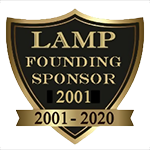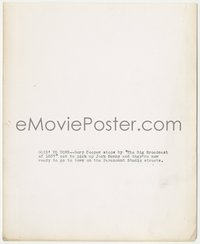eMoviePoster.com
Auction History Result 7p1359 GARY COOPER/JACK BENNY 8x10 key book still 1936 both riding to town on Gary's personal bike! Date Sold 11/19/2024Sold For: Login or Register to see sold price. An Original Vintage 8 1/4" x 10" [21 x 25 cm] Key Book Still (Learn More) Gary Cooper was born Frank James Cooper in Helena, Montana, USA in 1901. His mother was English born, and he and his brother were sent to an English boarding school to be educated when they were young, but when WWI broke out, they were brought home. His father was a judge who also owned a ranch, and Cooper went to college, but did not graduate, and ran his father's ranch afterwards, and also drew some cartoons for the local paper. When he was 23 his father left the bench and sold the ranch and his parents moved to California, and because Cooper could not make a living at his cartooning, he moved with them. After a year of odd jobs, he started getting extra roles in movie westerns. He signed a contract with Paramount, and changed his first name to Gary. Cooper got progressively better roles in non-talkie movies, and had romances with some of his more famous co-stars, including Clara Bow and Lupe Velez. In 1927, he played a small, but important role of a doomed flyer in Wings, which was a major breakthrough for him, and led to many better starring roles the following year. In 1929 he starred as the title character in The Virginian, which was made in both a talkie and non-talkie version. He had become the man that women everywhere swooned over, and men wanted to be like him. In 1930 he starred in Morocco, opposite Marlene Dietrich, and in 1932 he was hand picked by Hemingway to star in A Farewell to Arms, and in 1936 he starred in Frank Capra's Mr. Deeds Goes To Town (nominated for the Best Actor Academy Award for this film). He had his pick of movies, and many of the ones he turned down were then offered to similar actor Joel McCrea, who basically lived in Cooper's shadow throughout the 1930s. He turned down the lead role in Capra's Mr. Smith Goes to Washington (it started out as a Mr. Deeds sequel), and James Stewart got the role. He turned down the lead in Stagecoach, and that part made John Wayne a major star after toiling in B-westerns for many years. His greatest blunder was turned down the role of Rhett Butler in Gone with the Wind. He said at the time, "Gone with the Wind is going to be the biggest flop in Hollywood history. I'm glad it'll be Clark Gable who' falling flat on his nose, not me"! In 1941, Alvin York, the most decorated soldier in WWI, finally agreed to a movie being made of his life (to help recruiting efforts in WWII), but he insisted that only Cooper could play him, and Cooper won his first Oscar for that role in Sergeant York. The next year Lou Gehrig tragically died, and Cooper played him superbly in The Pride Of The Yankees (nominated for the Best Actor Academy Award for this film), and his "Today I am the luckiest man on the face of the Earth" speech is one of the great moments in movie history! He was Robert Jordan in Hemingway's For Whom The Bell Tolls (nominated for the Best Actor Academy Award for this film), and Ayn Rand picked him to play Howard Roark in The Fountainhead. In 1952 he had one of the finest roles of his career, as Will Kane in High Noon, and he won a second Oscar. In 1960 he got prostate cancer, and he died the following year, at 60 years of age. There will never be another star like Gary Cooper! He stayed a major leading actor for 25 solid years, starring in around 90 movies, and during that time he was the lead in important movies of all sorts, because so many writers, directors, and co-stars wanted him for their star! I highly recommend all the movies noted above, but you really can't go wrong with any Gary Cooper movie, for his presence elevated even his lesser movies into something worth watching! AND Jack Benny was born Benjamin Kubelsky in Chicago, Illinois in 1894, but he grew up in nearby Waukegan, Illinois. He was the son of Polish Jewish immigrants, and he started playing the violin at 6 years of age. He was kicked out of school and failed at every regular business he tried, so while still a teen he started playing the violin at vaudeville houses. He had a series of straight musical acts (and changed his name and the act's name several times) and he even "played the Palace" (the greatest vaudeville theater) but he bombed out and joined the Navy. He played the violin for the sailors, and when they booed him he started telling jokes about how bad he was, and they loved it, and his act was born! He left the Navy and returned to vaudeville with a one-man violin comedy act, and in 1922 he met Sadye Marks, and and they married in 1927, and she joined his act under the name of Mary Livingstone. In 1929, MGM signed him to a contract but they didn't know what to do with him and he only made a few movies, and he went to the Earl Carroll's Vanities. In 1932, he started The Jack Benny Program on NBC radio, and it was a huge hit. He soon developed the exact same persona he later used on his TV show, with the center around his cheapness and his vanity, and he was the butt of most jokes. He had a great mock feud with Fred Allen, and his wife played his girlfriend on the radio show, and all the main people who were later on the TV show were also on the radio show, including Eddie 'Rochester' Anderson, the great African American performer. The radio show had all the characters playing "themselves" and they would spend each episode in "real-life" situations. In 1950, Benny moved the show to TV, where it was equally popular, and audiences finally got to see what a master physical comedian he was, with his dead-pan facial expressions and gestures. Entire books can and have been written about how wonderful Benny's show was, and if you have never seen it, I urge you to get some and see some of the best TV comedy of all time! You'll see how Larry David and Jerry Seinfeld pretty much lifted the entire premise of their show from Benny (not that there's anything wrong with that) and Johnny Carson's entire comic delivery came largely from Jack Benny's. Of course, Jack Benny also made some movies in the 1930s and 1940s, and some were quite good. Likely the best of these was as Shakespearian actor Joseph Tura in Ernst Lubitsch's "To Be or Not to Be" ("So they call me Concentration Camp Erhard!"). Benny had so many great recurring gags (he was always 39, he was a terrible violin player, etc, etc), and his ensemble cast was a well oiled machine that never failed (and most of the biggest names in Hollywood consented to guest on his show). See at least a few of episodes of his TV show and you are likely to become hooked! Benny passed away in 1974 at the age of 80. Important Added Info: Note that this cool key book still shows Gary Cooper picking up Jack Benny from the set of the movie he was working on, "The Big Broadcast of 1937", and riding off on Gary's personalized bike! Note that this still is a key book still, printed on a deluxe heavyweight paper stock. Many studios spent extra money to have their most special photos, the key book stills, either backed with linen or printed on a heavy paper, both of which enhanced their durability. They had an extra 1" at the left or top, with punch holes, because of how they were stored. Key book stills are far more rare than regular stills, which has increased their popularity among collectors, since only a few keybooks were manufactured per film, and a key book still is guaranteed to be authentic. Someone trimmed away the extra 1" from the top of the still. Condition: very good. The top 1" was neatly trimmed off (see above) and there is some minor wear around the edges. Otherwise, the still is in nice condition! Learn More about condition grades 

Postal Mailing Address:
Bruce Hershenson, P.O. Box 874, West Plains, MO 65775. (For our UPS or FedEx address, click here) phone: +1 417 256-9616 fax: +1 417 257-6948 E-mail: Contact Us Hours of Operation: Monday - Friday 8:30 AM - 12:00 PM & 1:00 PM - 5:00 PM (CST) |
|||||||||||||







